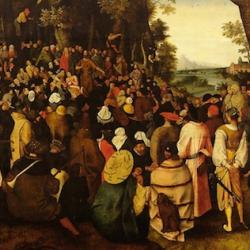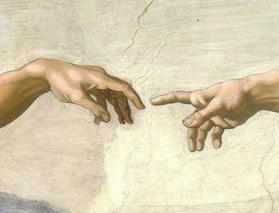Weddings are beautiful; few events are more so: The silken cascade of the bride’s dress, the sanctuary warm with candlelight, the austere elegance of a black tuxedo, the dignified choreography of procession and recession, the indescribable transcendence of Jupiter straining to burst the space of the sanctuary.
Weddings are beautiful, and therefore weddings also evoke beauty. Something there is about a wedding that inspires beauty ?Ethat inspires art, music, poetry. What went on in the last frantic weeks before this wedding was not merely an effort to make the wedding beautiful. Love is always already a collaborative work of art: two lives pursuing harmonization, two independent lines reaching for rhyme, two relatively unformed persons molding one another, a man and a woman learning to dance in a single movement. As celebrations and formalizations of love, weddings do not need to be made beautiful; they are beautiful. Our preparations are efforts to make that beauty more visible, audible, and tangible.
And, beyond this, the frantic preparations were a response to the unimagined beauty of that wedding that we see distantly before us, as through a glass darkly. Every wedding radiates with the glory of the final wedding that John glimpsed in vision. As with all art, the art of a wedding and the art of love involve a bestowal of beauty because they are first responses to beauty.
In his poem, “Prothalamion,” Edmund Spenser described a splendid wedding. He imagined the bride and groom as stately swans swimming down the Thames, greeted by troops of nymphs strewing flowers in the river. Of the nymphs, he wrote:
Seemed they never saw a sight so fair,
Of fowls so lovely that they sure did deem
Them heavenly born . . .
For sure they did not seem
To be begot of any earthly seed,
But rather angels, or of angels’ breed;
Yet were they bred of summer’s-heat, they say,
In sweetest season, when each flower and weed
The earth did fresh array,
So fresh they seemed as day,
Even as their bridal day, which was not long:
Sweet Thames run softly, till I end my song.
Weddings are beautiful, but too many marriages are not. Surveying the
waste land of modern life, love, and marriage, T. S. Eliot subverted Spenser’s vision of a an unearthly wedding. He wrote:
The nymphs are departed.
Sweet Thames, run softly, till I end my song.
The river bears no empty bottles, sandwich papers,
Silk handkerchiefs, cardboard boxes, cigarette ends
Or other testimony of summer nights. The nymphs are departed.
And their friends, the loitering heirs of city directors;
Departed, have left no addresses . . . .
Sweet Thames, run softly till I end my song,
Sweet Thames, run softly, for I speak not loud or long.
Marriages that begin in beauty may degenerate into endless bickering, long and silent resentments, incessant recriminations and reprisals, and finally the wrenching death of divorce. Few events in our world are more spectacular than a celebrity wedding, but few are more pathetically terrible than the often protracted and always public decay of a celebrity marriage. Dying is always ugly, and the death of a marriage is always at least a double death. As Eliot said, for many today “the nymphs are departed.”
How does this happen? How do marriages begin with beauty end in ugliness?
Some marriages, paradoxically, end in ugliness because of an overvaluation of beauty itself. We are constantly told by our culture ?Ein films, romantic novels, advertisements ?Ethat beauty, and beauty of a particular kind, is a sound basis, perhaps the only sound basis, for lasting love. As Robert Solomon has pointed out, the problem with this perspective is not so much that that beauty is superficial. In an important sense, beauty is more than “skin-deep”; it reveals character, because how we “make ourselves up” tells a great deal about what we want to “make of ourselves.” Rather, the primary problem is that the glamorous beauty promoted in advertizing and film “points in precisely the [wrong] direction for love ?Etoward admiration and worship rather than sharing, toward arousal instead of wisdom, toward superficial attraction rather than deep intimacy and knowledge.” Beauty “attracts,” but “‘attraction’ presupposes a distance, a distance which the intimacy of love denies.” What passes for beauty today is often vain, childish, narcissistic, and what attracts is less the seductiveness of beauty than a certain condescending attitude of unavailability, and unavailability is the very antithesis of love.
Idolization of beauty often takes another form as well. A man shops for a wife ?Eor, a woman picks out a man ?Eas an attractive adornment, an appendage, a trophy. Couples may choose a lifestyle ?Ethe best home in the best neighborhood, the latest model car, a perfectly manicured lawn, the right clubs and the right friends ?Efor the sole purpose of impressing others with the elegance of their lifestyle. Living and loving, including marriage, becomes a display. Such aestheticism is an enemy to life. Instead of living, aesthetes of this sort stand to the side examining their lives, barking instructions like a film director, adding a dash of color here, smoothing off a rough piece of stone there. Such aestheticism has little to do with living, and this kind of self-display has nothing at all to do with Christian living.
Christians are rarely in danger of making the mistakes I’ve outlined, though we are never above temptation of any sort. But Christians today are much more in danger of making another kind of mistake that has remarkably similar results. Many Christians consider beauty to be irrelevant for life and marriage, tolerable for the wedding day but dispensable for the rest of life. That too is a prescription for an ugly marriage following a beautiful wedding.
The pursuit of beauty in the proper sense is intimately conjoined with the pursuit of holiness, because the God we worship and serve is Beauty and is beautiful. This afternoon I want to remind you of things you have already embraced with enthusiasm, things that you have included in the blueprint of your life together. And this afternoon I want to remind you that you must persevere in these things if you hope to make your marriage as lovely as your wedding.
First, live in wisdom. What has wisdom to do with beauty? Much in every way. Wisdom, of course, involves prudence, practicality, down-to-earth common sense, but in Scripture wisdom also includes an irreducible aesthetic element. The Hebrew word for wisdom means “skill,” and it can be used to describe craftsmanship, as it does in the case of Bezalel and Oholiab, who were given wisdom to construct the furnishings of the tabernacle. When applied to life, the word does not lose its aesthetic, artistic, or craft dimension. Living wisely means living arfully.
Wisdom is often an issue of “fittingness,” and this is an aesthetic criterion. The right words at the right time are not only ethically good and rationally sound but “like apples of gold in a setting of silver,” which is to say, fitting words are beautiful. In your marriage you will quickly learn, if you have not already, how damaging unfitting words can be. And the criterion of fittingness applies to action as much as to words. Bringing a bouquet of flowers at the wrong time can seem like an attack, whatever your motives. Doing the right thing at the right time is wisdom, and this wisdom is a form of craftsmanship, learned over a lifetime of training.
Wisdom, the Proverbs tell us, further, is better than silver, gold and precious jewels ?Enot only is it more valuable, but more beautiful. Wisdom is a beautiful woman, and Lady Wisdom offers to ad
orn those who find her with a crown of beauty and necklaces. It is no accident that the same Solomon who wrote many of the Proverbs also wrote the Song of Songs, for this erotic poem too is about the desire for wisdom, which is finally also the desire for beauty. Live in wisdom; live in the fear of the Lord, for the fear of the Lord is the beginning of wisdom, and the beginning of beauty.
Second, live in hope. What has hope to do with beauty? Much in every way. To live in hope is to live toward the future, desiring and expecting God to fulfill His promises. All the hope we have as Christians is fundamentally a hope for beauty. God created Adam and Eve in glory and splendour, but they sinned and fell short of the glory of God. All of us have also fallen short of God’s glory, but the great hope of the gospel is a hope for restored glory. We see and know and experience present glory only as a participation in future glory. The glory of your marriage will be evident only if it is an anticipation of the glory of the union of Christ and His church in the marriage feast of the Last Day.
To live in hope is to live toward the future, and this has very concrete implications for your marriage. One of the most debilitating habits in marriage is the stubborn refusal to leave the past behind and move toward a new future. Yesterday’s unthinking criticism hangs like the shadow of death over today and endless tomorrows; last year’s forgotten anniversary poisons every future anniversary; sins unforgiven and unforgotten lend their darkly discordant overtones to every conversation. You can have a happy marriage only through ready confession of sin, continual forgiveness and repeated reconciliations, unwavering forbearance and gentleness. By the same token, you can achieve a beautiful marriage only by following Paul’s instructions to “be kind to one another, tender-hearted, forgiving each other, just as God in Christ also has forgiven you.” Forgiveness is always a turn from the past sin to future glory; forgiveness is the concrete expression of hope, a hope for final reconciliation, a hope of beauty. Live in hope, live in the hope of glory, so that future glory might be expressed in your marriage.
Finally, live in faith. What has faith to do with beauty? Much in every way. Faith always arises from despair of your own resources and options. Faith is, as Paul said of Abraham’s faith, hope against hope ?Efaith is hope in God that competes with and finally defeats hopelessness in ourselves. Faith means trusting God to work in us so that we may work out our salvation with fear and trembling. Faith is openness and surrender to God’s work in, with, and through us. Faith is ecstasy, joyfully taking one’s stand outside oneself, in God.
We are glorified by faith as much as we are justified and sanctified through faith. The God who works in us is the original, the infinite beauty, and we rely on Him to display that beauty in us. God’s very being is “love, [the Father’s] delight in the glorious radiance of his infinite Image, seen in the boundlessly lovely light of his Spirit.” And creation, according to Gregory of Nyssa [in David Hart’s summary], “is a symphonic and rhythmic complication of diversity, motion and rest, a song praising God, [who is] the true, primordial, archetypal music, in which human nature can glimpse itself as in a mirror.” We are, in short, we are “music moved to music.” Faith means trusting God to play his infinite fugue through our finite lives, to sing His eternal song in our temporality, to transpose the harmonious polyphony that is His uncreated life into the key of created existence.
And He does do exactly that. Our limitations and sins are no limitations for Him. Gregory compares the soul that receives God’s blessings “to a vessel endlessly expanding as it receives what flows into it inexhaustibly.” Receiving God’s beauty in faith makes us “ever more capacious and receptive of beauty.” So it will be with your marriage, if it is grounded in faith, the faith of each of you, and your faith together. Live in faith, trusting God to play out His eternal song with ever-increasing vibrancy through the harmony of your marriage.
Live in wisdom, together as you have separately; live in hope, as man and wife; live in faith, as two made one flesh. Then your marriage will be beautiful, and will be progressively transformed from glory to glory, from beauty to beauty, and will continually and increasingly display the splendor not only of your wedding day, but the splendor of the Endless God who will unveil Himself in the Endless day, which is also a wedding day.
In the Name of the Father, and of the Son, and of the Holy Spirit. Amen.











